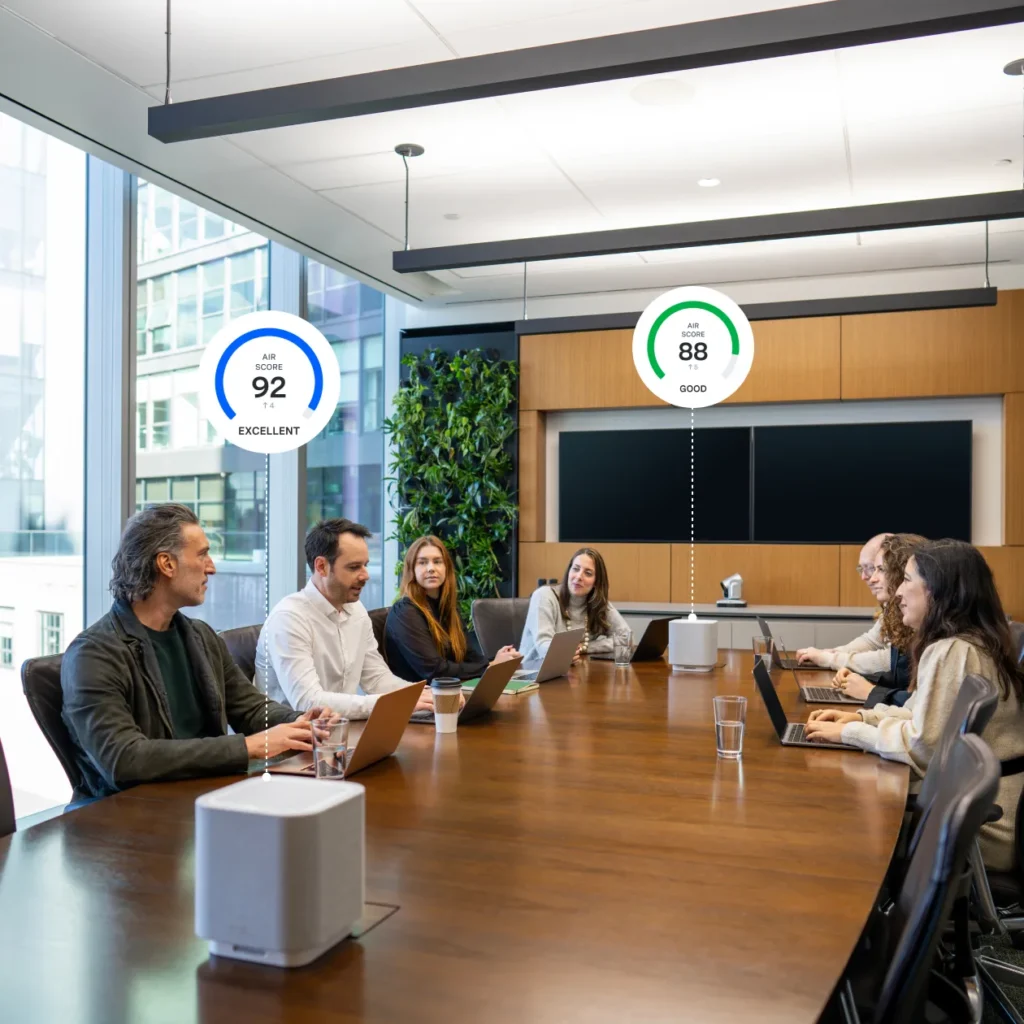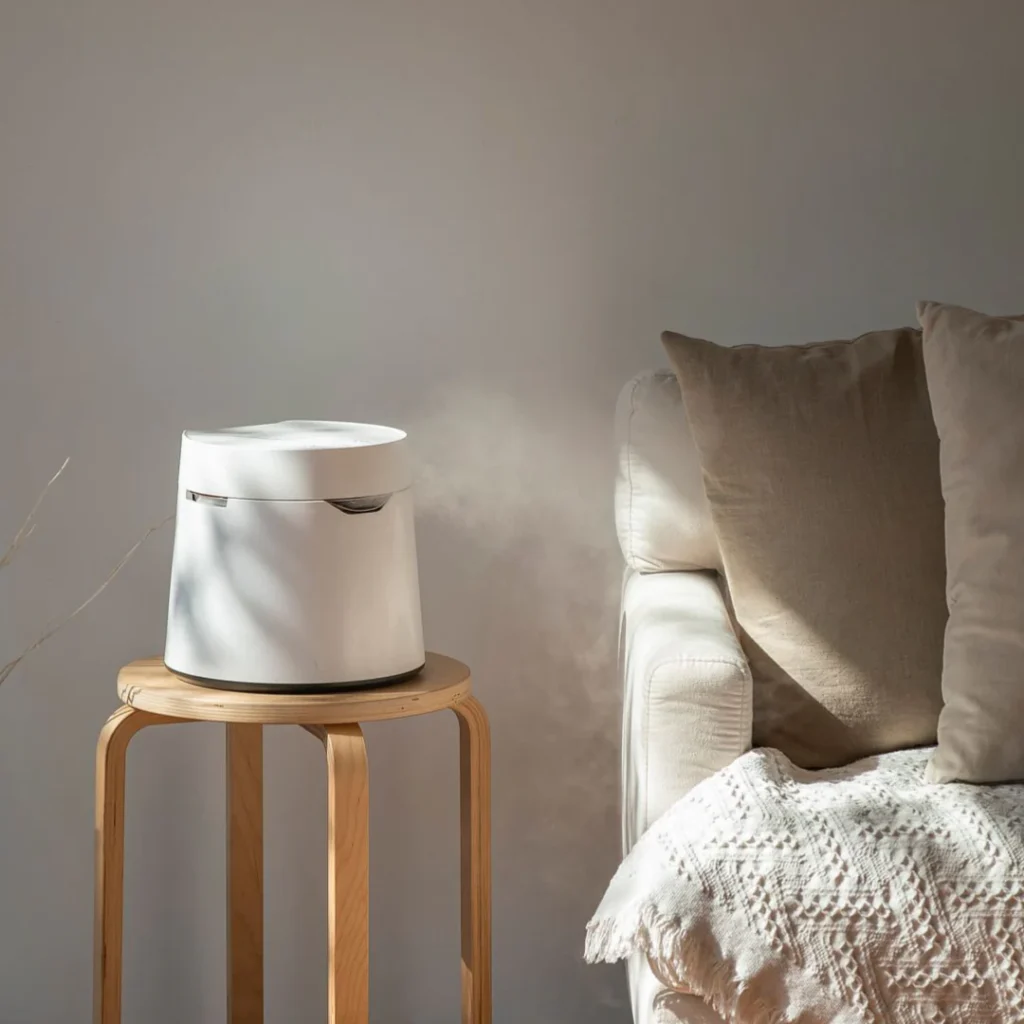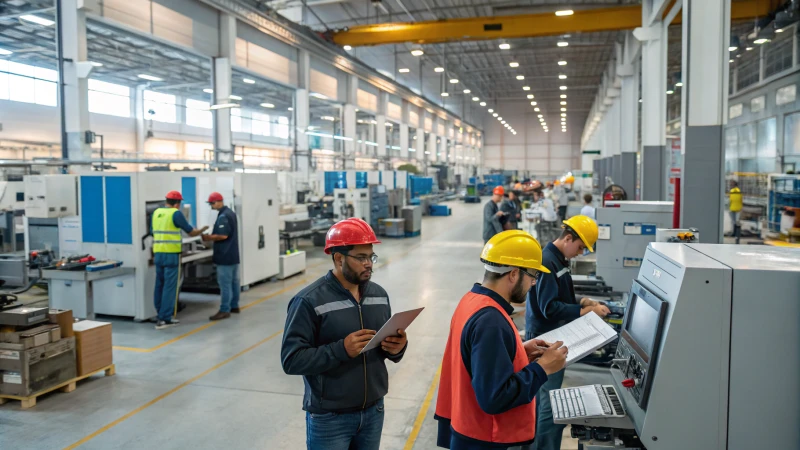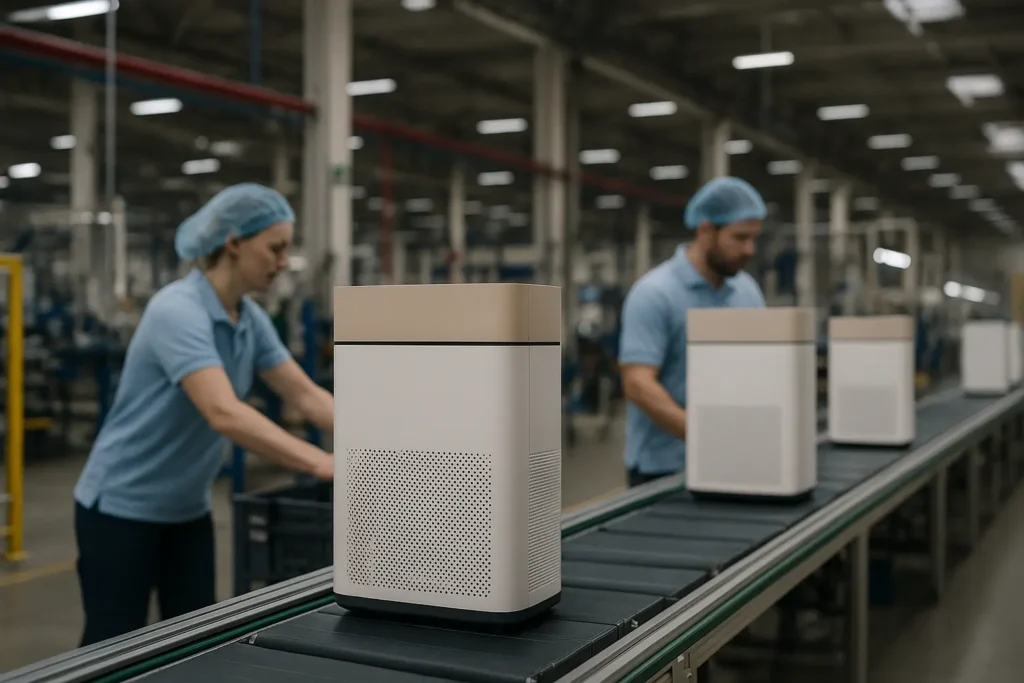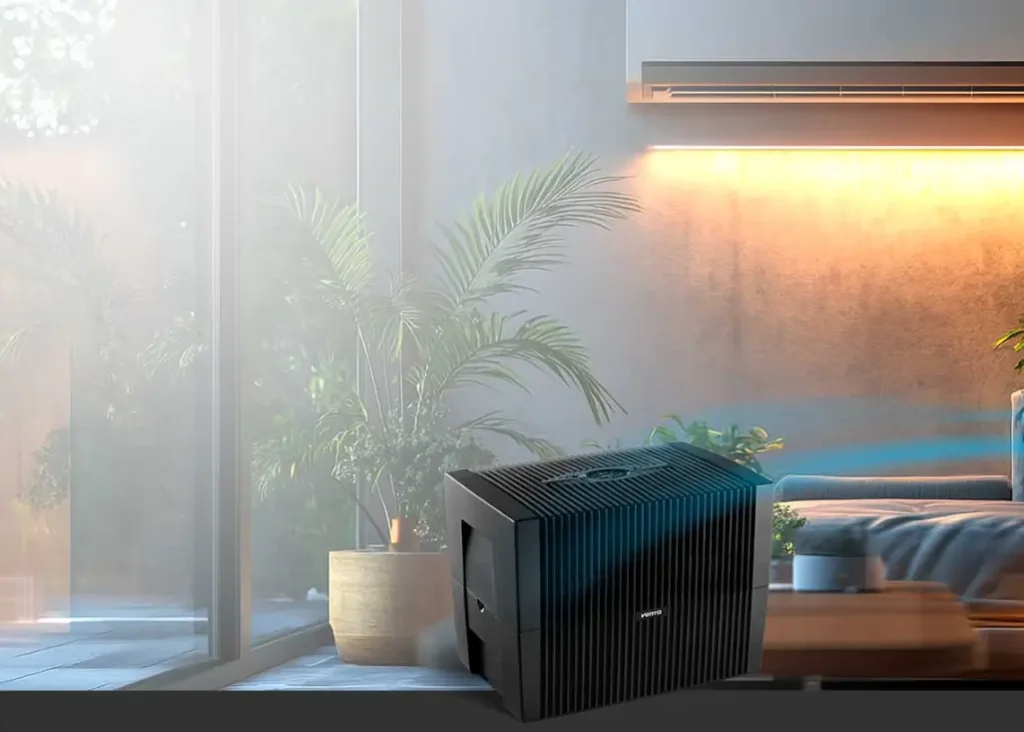
업무용 공기청정기에 대한 OSHA의 세부 규정을 살펴보는 것은 마치 큰 퍼즐을 맞추는 것과 같습니다.
공기청정기가 상업용 프로젝트의 OSHA 표준을 충족하려면 성능 지표, 안전 요구사항, 유지보수 절차를 평가하는 것이 필수적입니다. 여기에는 정화 효율, 소음 수준 및 안전 기능이 국가 규정을 준수하는지 확인하는 것이 포함됩니다.
이것은 기본적인 이해를 제공합니다. 각 부분을 더 자세히 살펴보고 완전한 규정 준수에 대해 명확하게 알아보세요. 더 자세히 살펴보면 규정 준수에 도움이 되는 세부 조치, 모범 사례 및 전문가 견해를 찾을 수 있습니다.
공기청정기는 OSHA 표준을 충족하기 위해 HEPA 필터가 있어야 합니다.False
OSHA는 HEPA 필터를 직접 요구하지 않으며 일반적인 공기 청정도에 초점을 맞추고 있습니다.
상업용 공기청정기의 핵심 성과 지표는 무엇인가요?
우수한 공기 품질을 달성하려면 상업용 공기청정기의 중요한 조치를 파악하는 것이 중요합니다.
상업용 공기청정기의 주요 성능 지표에는 정화 효율, 소음 수준, 풍량 등이 있습니다. 이러한 지표는 상업 환경 내 공기질 개선에 있어 공기청정기의 효과에 직접적인 영향을 미칩니다.

정화 효율에 대한 이해
정화 효율은 가장 중요한 요소 중 하나입니다. 성과 지표1 상업용 공기청정기의 경우. 이는 먼지, 꽃가루 및 기타 공기 중 입자와 같은 오염 물질을 공기에서 제거하는 장치의 기능을 나타냅니다. 정화 효율이 높으면 공기청정기가 실내 공기 오염을 효과적으로 줄일 수 있으며, 이는 공기질이 건강과 생산성에 큰 영향을 미칠 수 있는 상업 환경에서 매우 중요합니다.
측정 방법:
- 깨끗한 공기 전달률 (CADR): 이 측정 항목은 청정기가 제공하는 필터링된 공기의 양을 분당 입방피트(CFM) 단위로 측정합니다. 더 높음 CADR 값은 더 나은 성능을 의미합니다.
- 필터 기술: HEPA 또는 활성탄과 같이 사용되는 필터의 유형도 효율성에 영향을 미칩니다.
노이즈 수준 평가
소음 수준은 특히 사무실이나 식당과 같이 과도한 소음이 방해가 될 수 있는 환경에서 중요한 고려 사항입니다. 상업용 공기청정기는 성능과 작동 시 조용함 사이의 균형을 유지해야 합니다.
소음 수준에 영향을 미치는 요인:
- 팬 속도: 속도가 빠를수록 일반적으로 소음이 더 커집니다. 가변 속도 설정이 가능한 모델을 찾아보세요.
- 디자인: 전반적인 디자인 및 빌드 품질도 소음 감소에 기여할 수 있습니다.
공기량 용량 평가
풍량 용량은 종종 CADR는 특정 시간 내에 공기청정기가 처리할 수 있는 공기량을 나타냅니다. 이는 모든 구역을 적절히 정화하기 위해 더 큰 용량이 필요한 넓은 공간에서 특히 중요합니다.
| 정화기 모델 | CADR (CFM) | 권장 객실 크기 |
|---|---|---|
| 모델 A | 300 | 최대 400평방피트 |
| 모델 B | 450 | 최대 600평방피트 |
정기 유지보수의 중요성
직접적인 성능 지표는 아니지만, 정기적인 유지보수를 통해 공기청정기가 최고의 효율로 계속 작동할 수 있습니다. 여기에는 제조업체 지침에 따라 필터를 교체하고 구성품을 청소하는 것이 포함됩니다.
이러한 지표가 상호 작용하는 방식과 그 의미를 종합적으로 이해하려면 다음을 참조하세요. 공기 품질2에서 전문가 리뷰를 참조하고 자세한 제품 비교를 해보세요.
HEPA 필터는 공기 정화에 가장 효율적입니다.True
HEPA 필터는 99.97%의 입자를 걸러내어 공기질을 개선합니다.
팬 속도가 높을수록 공기청정기의 소음 수준이 줄어듭니다.False
팬 속도가 빠를수록 소음이 커지고, 설정에 따라 소음이 줄어듭니다.
안전 요건은 공기청정기 설계에 어떤 영향을 미치나요?
안전 규칙은 공기청정기가 만들어지는 방식에 큰 영향을 미칩니다. 이는 사용자의 안전을 지키고 제품의 신뢰성을 보장합니다.
안전 요구 사항은 사고를 예방하고 국가 표준을 준수하기 위해 전기 안전, 재료 선택 및 작동 기능을 규정하여 공기청정기 설계에 영향을 미칩니다.
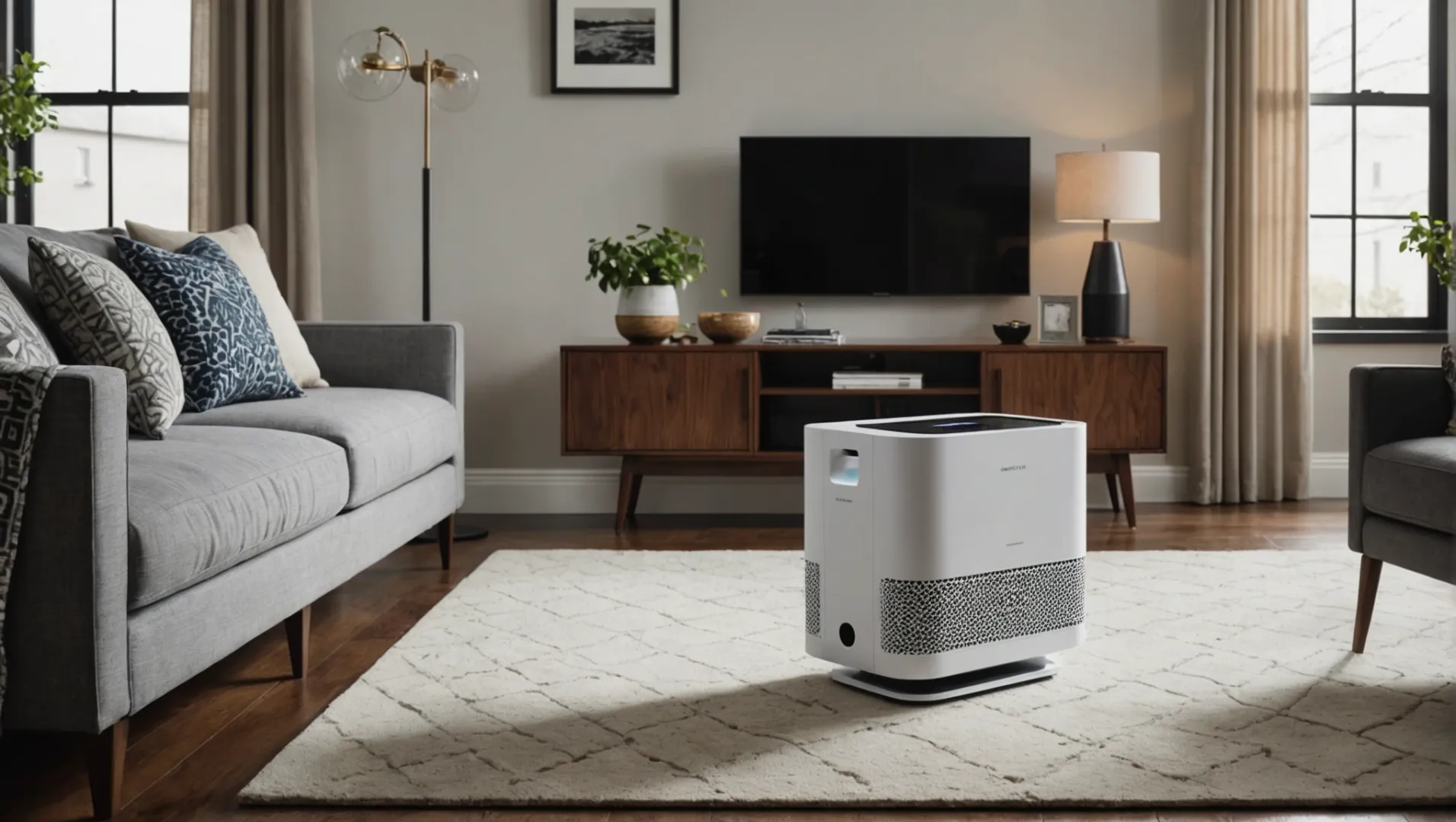
전기 안전에 대한 이해
전기 안전은 다음 분야에서 매우 중요합니다. 공기 청정기 디자인3. 공기청정기는 종종 몇 주 동안 쉬지 않고 작동하기 때문에 강력한 전기 부품이 필요합니다. 설계자는 단락이나 전기 화재를 차단하기 위해 모든 전기 회로를 절연하고 접지해야 합니다. IEC 60335와 같은 국내 및 국제 안전 규정을 준수하면 사용자에게 신뢰할 수 있는 제품임을 보여줄 수 있습니다.
소재 선택 및 내구성
공기청정기의 소재는 안전을 위해 필수적입니다. 제조업체는 내구성과 내화성을 모두 갖춘 소재가 필요합니다. 이 단계는 특히 하루 종일 기계가 작동하는 장소에서 화재 위험을 줄여줍니다. 이제 더 많은 디자이너들이 글로벌 지속가능성 목표를 달성하기 위해 친환경 소재를 선택하고 있습니다.
폭발 위험 예방
일부 장소에서는 불안정한 가스나 화합물로 인한 폭발이 매우 우려됩니다. 이러한 지역을 위한 공기청정기에는 이러한 위험을 감지하고 줄이기 위한 특수 필터와 센서가 있습니다. 방폭 설계는 유럽의 ATEX와 미국의 NEC와 같은 표준을 따릅니다.
규정 준수 및 테스트
공기청정기 디자인은 시장에 출시되기 전에 엄격한 테스트를 통과합니다. 테스트는 소음, 효율성 및 안전 측면을 확인합니다. 설계 팀은 종종 타사 연구소와 협력하여 UL, CE 또는 CSA 마크와 같은 표준을 확인합니다. 규정 변경 사항을 이해하면 지속적인 규정 준수에 도움이 됩니다.
사용자 안전 기능
최신 공기청정기에는 다양한 사용자 안전 기능이 탑재되어 있습니다. 여기에는 과열 또는 필터 막힘에 대한 자동 차단, 어린이 잠금, 유지보수를 위한 간단한 알림 등이 포함될 수 있습니다. 각 기능은 사용자 상호 작용을 개선하고 가능한 위험을 줄이려고 노력합니다.
제조업체는 이러한 안전 요구사항에 집중함으로써 소비자와 신뢰를 쌓고 믿을 수 있고 유용한 제품을 만듭니다. 이러한 요소는 설계 프로세스의 핵심이며 공기청정기 개발에 영향을 미칩니다.
공기청정기 설계에서 전기 안전은 매우 중요합니다.True
전기 안전은 공기청정기가 잘 작동하여 화재를 막는 데 도움이 됩니다.
모든 공기청정기는 친환경 소재를 사용합니다.False
일부 공기청정기는 친환경 소재를 사용하지만, 모든 공기청정기가 친환경 소재를 사용하는 것은 아닙니다.
어떤 유지 관리 관행이 OSHA 표준 준수를 보장하나요?
OSHA 표준을 준수하려면 상업용 공기청정기의 성능과 안전을 모두 보호하면서 세심하게 유지 관리해야 합니다.
공기청정기의 정기적인 유지관리 관행에는 필터 교체, 시스템 검사 및 성능 평가가 포함되어야 OSHA 표준을 준수할 수 있습니다. 이러한 관행은 운영 효율성을 유지하고, 안전 기능을 그대로 유지하며, 규정 준수 위반을 방지하는 데 도움이 됩니다.
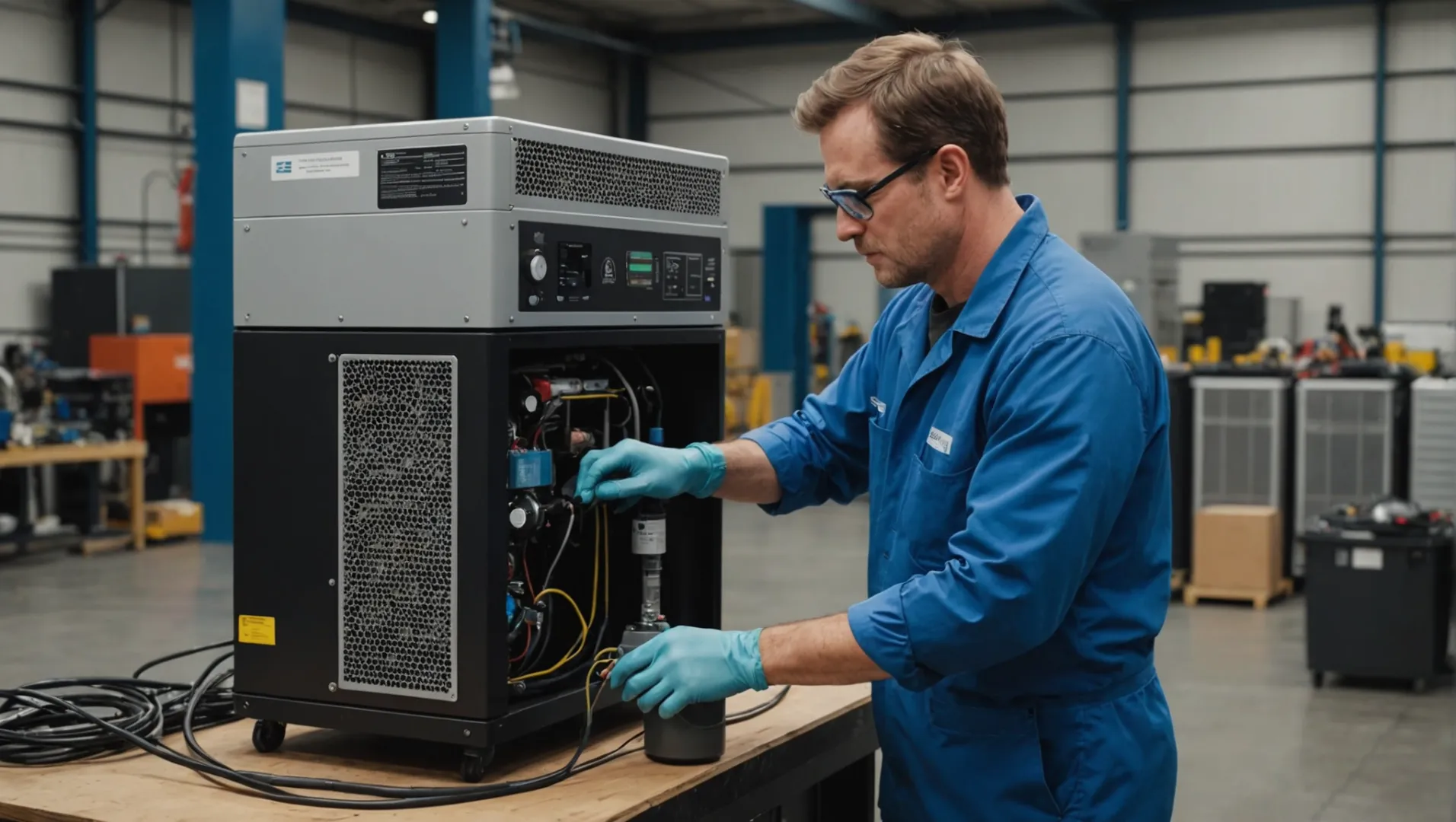
공기청정기 관리를 위한 OSHA 규정 이해
사업장에서 공기청정기를 관리하려면 미국 직업안전보건국(OSHA) 규정을 준수해야 합니다. 이 가이드라인은 안전과 최적의 성능을 보장하기 위한 필수 관행에 대해 설명합니다.
-
정기 필터 변경: 필터는 제조업체의 권장 사항에 따라 점검하고 교체해야 합니다. 이를 통해 깨끗한 공기를 유지하고 공기청정기가 효율적으로 작동할 수 있습니다. 필터가 더럽거나 막히면 시스템에 스트레스를 주어 안전 위험을 초래할 수 있습니다.
-
시스템 점검: 정기적인 점검이 중요합니다. 전기 부품을 점검하여 화재 위험을 방지하고 모든 부품이 제대로 작동하는지 확인하세요. 이러한 점검을 통해 마모가 심각한 문제가 되기 전에 미리 파악할 수 있습니다.
-
성능 점검: 정기적인 성능 평가는 OSHA 표준에 따라 정화 효율을 유지하는 데 도움이 됩니다. 공기 흐름, 청소 속도, 소음 수준과 같은 매개변수를 평가하여 시스템이 효과적으로 작동하는지 확인합니다.
문서화 및 규정 준수
모든 유지 관리 활동에 대한 철저한 기록은 규정 준수를 입증하는 데 매우 중요합니다.
-
유지 관리 참고 사항: 필터 교체, 검사 결과, 수리 등 모든 유지보수 활동을 문서화하세요. 이 문서는 종종 OSHA 감사 시 요구되는 문서입니다.
-
직원 교육: 공기청정기를 다루는 직원에 대한 교육도 매우 중요합니다. 교육에는 안전한 취급 절차, 안전 프로토콜 및 비상 조치에 대한 내용이 포함되어야 합니다.
일반적인 관리 실수와 이를 방지하는 방법
탄탄한 유지 관리 계획이 있더라도 일부 실수로 인해 규정 준수가 위태로워질 수 있습니다:
-
사소한 문제 무시하기: 비정상적인 소음이나 약간의 성능 저하와 같은 사소한 문제는 즉시 해결해야 합니다. 이러한 문제를 조기에 해결하면 더 큰 문제가 발생하는 것을 방지할 수 있습니다.
-
제조업체 지침이 누락되었습니다: 각 정수기마다 따라야 하는 특정 유지 관리 요구 사항이 있을 수 있습니다. 제조업체 지침 이해4 는 규정 준수의 핵심입니다.
이러한 관리 방법을 준수하고 일반적인 실수를 피함으로써 기업은 공기청정기를 OSHA 규칙에 맞게 유지하여 상업 공간에서 안전하고 효율적으로 운영할 수 있습니다.
OSHA 준수를 위해 정기적인 필터 교체는 필수입니다.True
안전을 위해 필터 교체와 같은 잦은 유지 관리가 필요한 OSHA 규정입니다.
공기청정기의 사소한 문제를 무시해도 규정 준수에 영향을 미치지 않습니다.False
작은 문제를 무시하면 문제가 커져 OSHA 규정을 따르지 않는 결과를 초래할 수 있습니다.
OSHA 공기질 기준을 충족하기 위해 피해야 할 일반적인 함정이 있나요?
OSHA 공기질 규정을 따르는 것은 어려울 수 있습니다. 성공을 위해 이러한 실수를 피하세요.
OSHA 공기질 기준을 준수하는 데 있어 흔히 발생하는 함정으로는 정기적인 유지관리 소홀, 규정 오해, 부적절한 성능 모니터링 등이 있습니다. 규정 준수를 보장하려면 사전 예방적 관리, 업데이트된 지침 준수, 유능한 인력 고용이 필요합니다.
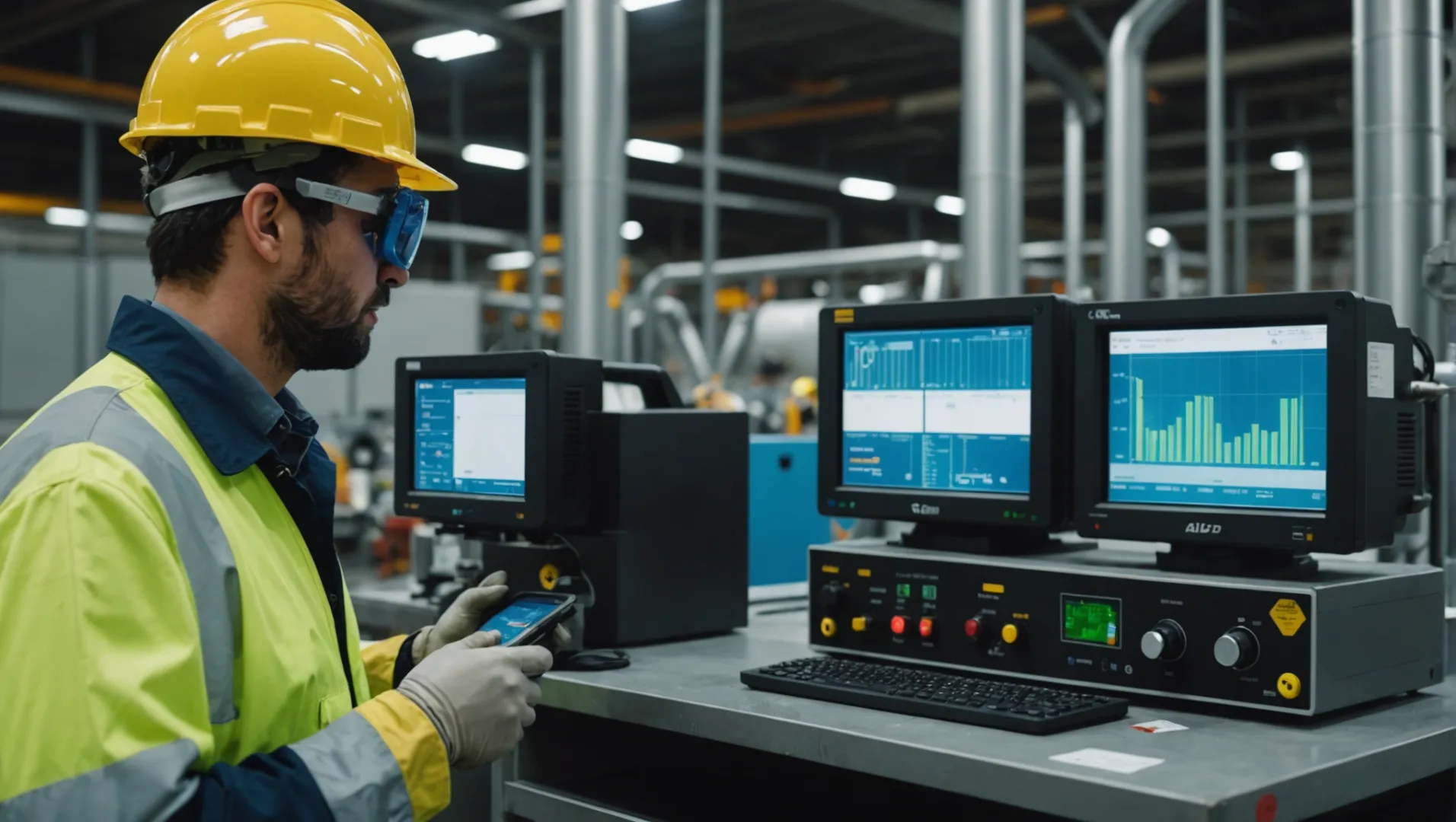
OSHA 규정 오해
기업이 직면하는 가장 일반적인 함정 중 하나는 다음과 같은 오해입니다. OSHA 규정5. 기업들은 종종 모든 공기청정기가 이러한 기준을 자동으로 충족한다고 생각하지만, 그렇지 않습니다. 적절한 장비를 선택하려면 허용 노출 한도(PEL) 및 권장 안전 수칙과 같은 특정 요건을 철저히 이해해야 합니다.
정기 유지 관리 무시
정기적인 유지 관리를 소홀히 하는 것도 흔한 문제 중 하나입니다. 공기청정기는 효과적이고 안전한 상태를 유지하려면 정기적인 관리가 필요합니다. 이 과정에는 필터 교체, 부품 청소, 점검이 포함됩니다. 일정을 따르지 않으면 성능이 저하되고 잠재적인 문제가 발생할 수 있습니다.
| 유지 관리 작업 | 빈도 |
|---|---|
| 필터 변경 | 3~6개월마다 |
| 부품 청소 | 월간 |
| 시스템 점검 | 분기별 |
성능 저하 점검
공기청정기가 얼마나 잘 작동하는지 확인하는 것은 OSHA 규칙을 준수하는 데 있어 핵심입니다. 일부 회사에서는 이 단계를 놓쳐 문제를 제때 발견하지 못하는 경우가 있습니다. 공기질 점검과 같은 정기적인 테스트를 수행하면 문제를 조기에 발견하는 데 도움이 될 수 있습니다.
비숙련 근로자 고용
마지막으로, 적절한 기술이 없는 근로자를 고용하면 규정 준수 노력이 수포로 돌아갈 수 있습니다. 공기질 시스템을 관리하는 작업자는 교육을 받고 OSHA 규정을 숙지해야 합니다. 투자 교육 프로그램6 를 사용하면 규정 준수 결과가 개선될 수 있습니다.
이러한 일반적인 실수를 이해하고 이를 방지하는 전략을 사용함으로써 기업은 공기질 시스템이 OSHA 표준을 준수하도록 할 수 있습니다.
OSHA 준수를 위해 정기적인 유지보수는 필요하지 않습니다.False
유지 관리를 무시하면 기능 저하와 규칙 위반이 발생할 수 있습니다.
모든 공기청정기는 자동으로 OSHA 표준을 충족합니다.False
모든 정수기가 규칙을 따른다고 믿는 것은 전형적인 실수입니다.
결론
OSHA 규정을 준수하면 더 안전한 작업장을 만들 수 있습니다. 성능, 안전 및 유지 관리에 집중하여 공기질을 개선하고 규칙을 준수하세요. 최신 정보를 파악하고 주도적으로 행동하세요.
-
정화 효율을 정확하게 측정하는 방법 알아보기: 1. 공기질 모니터. 실내 공기질 모니터는 공기청정기가 성공적으로 작동하는지 쉽게 확인할 수 있는 방법입니다. 그것은 또한 ... ↩
-
최적의 공기질을 유지하는 것이 중요한 이유를 알아보세요: 이 가이드는 사무실 건물에서 근무하는 사람들이 실내 공기질과 쾌적성 문제를 유발하는 요인에 대해 알아볼 수 있도록 돕기 위해 마련되었습니다. ↩
-
전기 안전 표준이 공기청정기의 안정적인 작동을 보장하는 방법을 알아보세요: 대부분의 전기 제품은 사용자 안전을 염두에 두고 설계되었지만 일부 제품은 의도치 않게 실내 공기질을 저하시킬 수 있습니다. 고전적인 ... ↩
-
제조업체로부터 직접 정확한 유지관리 단계를 배워 규정 준수를 보장하세요: 상업용 및 공공 건물의 공기 필터는 손상, 이물질, 밀폐 상태 등이 있는지 정기적으로 검사해야 합니다. 주변 지역은 ... ↩
-
주요 OSHA 공기질 규정 준수를 위한 이해..: 올바른 환기 및 건물 관리로 IAQ 문제를 예방하고 해결할 수 있습니다. OSHA에는 IAQ 표준이 없지만 환기에 대한 표준이 있습니다 ... ↩
-
OSHA 준수 기술을 향상시키기위한 효과적인 교육 프로그램을 찾아보십시오: OSHA 공인 온라인 아웃 리치 교육 제공 업체 - 360Training (OSHAcampus) - AdvanceOnline - CareerSafe (청소년 초점) - ClickSafety - HSI (Summit Training Source) ... ↩


